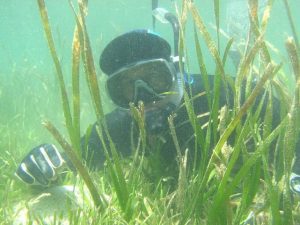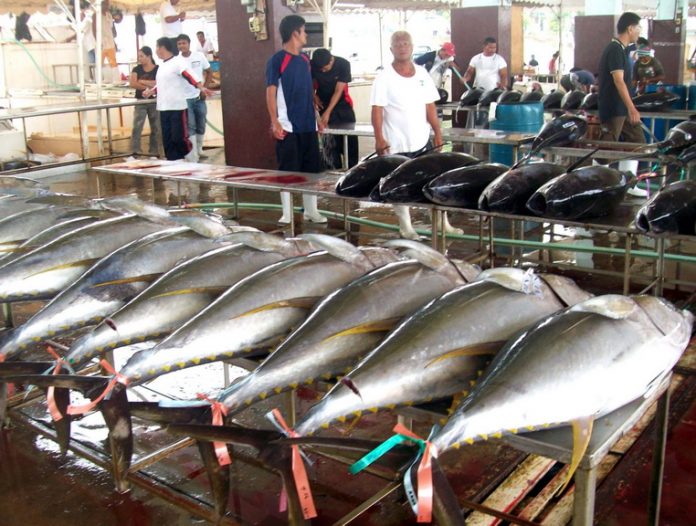“Southeast Asia contains 30% of the world’s reefs, 33% of the world’s mangrove resources, and at least 20% of its seagrasses. It also accounts for a quarter of global fish production supporting the livelihood of 60% of the people residing within 60 kilometers of the coast.” – Dr. Herminia A. Francisco, of the Economy and Environment Program for Southeast Asia
***
With the rampant mangrove denudation and coral reef destruction, seagrass beds – those discrete communities dominated by flowering plants with roots and underground stems – have become the “last frontier” of the country’s coastal resources.
“The whole central portion from low tide to the reef is inhabited by seagrass,” says Dr. Anitra Thorhaug, an American biologist who pioneered efforts in restoring seagrass habitats in the Philippines. “Yet corals and mangroves have reserved areas, seagrasses none.”
In Southeast Asia, most coral reefs are associated with seagrasses, according to Dr. Miguel D. Fortes, a marine scientist and the first Filipino to receive the prestigious International Biwako Prize for Ecology. “These two ecosystems could potentially supply more than one-fifth of the fish catch in the region,” he writes. “A total of 1,384 individuals and 55 species from 25 fish families have been identified from five seagrass sites in the Philippines alone.”
In terms of seagrasses in the world, the Philippines has the second highest number of species. Western Australia has more than 30 species of seagrasses while the Philippines has 18 species thriving along its coasts.
“Many plants and animals live in seagrass beds, which are rich in nutrients and whose physical structure protects young marine life from predators,” Dr. Fortes notes. “The major invertebrates found in the beds are shrimps, sea cucumbers, sea urchins, crabs, scallops, mussels, and snails. The major vertebrate species include fishes, reptiles and mammals.”
Seagrasses in the country covers an area of 27,282 square kilometers. They are widely distributed throughout the country – from Bolinao Bay (Pangasinan) in the north, Palawan and the Cebu-Bohol-Siquijor area to the center, and Zamboanga and Davao in the South.
“Seagrass beds are declining worldwide,” says Dr. Fortes. In the Philippines, 30%-50% of seagrass has been lost in the last 50 years.
The rapid disappearance of seagrass in the country is due to the increasing population’s multiple demands upon the country’s marine environment as source of food, avenues of transportation, receptacles of waste, living space and source of recreation and aesthetics pleasures.
 hThe seagrass ecosystem is likewise adversely affected by mining of industrial minerals; oil spills caused by accidents, operational shipping and refinery activities; dredging and illegal associates.
hThe seagrass ecosystem is likewise adversely affected by mining of industrial minerals; oil spills caused by accidents, operational shipping and refinery activities; dredging and illegal associates.
“Huge tracts of these productive habitats are being dredged, filled, polluted, exploited, converted to other coastal uses or simply being destroyed, all in the name of economic development,” Dr. Fortes deplores.
Population and overfishing
The rising number of Filipinos has contributed to the destruction of the country’s coastal ecosystems. Based on projections made by the Commission on Population using data from the Philippine Statistics Office, the will Philippines will be home to 105,758,850 by the end of the year.
“The continuing increase in population is due to relatively high fertility rates of Filipino women which is 3 children on average; however, 11 of the 17 regions show higher fertility rates than the national average,” said a report by the state-run Philippine News Agency.
As a result of the rapid increase of population, there are too many mouths to feed. “Life in the Philippines is never far from the sea,” wrote Joan Castro and Leona D’Agnes in a report published by Population Reference Bureau. “Every Filipino lives within 45 miles of the coast, and every day, more than 4,500 new residents are born.”
Dr. Robert Ginsburg, a marine scientist working with the Rosenstiel School of Marina and Atmospheric Science at the University of Miami, said that human beings have a lot to do with the rapid destruction of coastal ecosystems. For instance, “in areas where people are using coral reefs or where there is a large population, there are significant declines in coral reefs.”
Result of too many people: overfishing. “Overfishing is the primary cause of dwindling fish population,” writes Peter Weber in his report, Net Loss: Fish, Jobs and the Marine Environment.
In Southeast Asia, where the Philippines is located, “nearly all waters within 15 kilometers of shore are considered overfished,” deplored Dr. Edgardo D. Gomez, who used to be the director of the Marine Science Institute of the University of the Philippines at Diliman.
As fish become scarce, only those moneyed people can afford to buy them. When there are too many people who demand fish and the supply is limited, the price automatically goes up. That’s what the law of supply and demand is all about.
Aquaculture
One possible solution to the problem is aquaculture, the raising of fish in lakes, ponds and other bodies of water. In 1995, one in four food fish consumed by humans came from aquaculture.
But these bodies of water, where fish are farmed, are also experiencing some problems. Take the case of Laguna Bay, a 911-square-kilometer body of water into which 21 river tributaries drain. It reportedly supplies 30 to 40 percent of the total fish requirement of Metro Manila.
In the past, 23 endemic fish species inhabited the lake, including the monetary-valued white goby, grunt and catfish. Today, only six varieties of fish thrive in its water. Also at one time, 13 kinds of aquatic plants grow above the water. Now, only the lowly kangkong and the resilient water lily have survived the heavily polluted waters.
“From all indications, Laguna Lake is destined to become another classic case of ‘the tragedy of the Commons,” wrote Celso Roque in a foreword for Laguna De Bay: Problems and Options.
Saving coastal ecosystems
Before he ran for president, Rodrigo R. Duterte was quoted as saying: “Illegal fishing must stop. The bounty of our seas and waters is not or us alone. We must leave something for the future generation.”
But the question is: can it be stopped? Can the coastal ecosystems be restored to its former glory? Fortunately, there is still a glimmer of hope – that is, if Filipinos will work together.
“The degradation of our marine ecosystems has always been a gut issue as it pushes poverty deeper in the coastal communities through loss of livelihood, vulnerability to natural hazards, hunger and even health problems,” pointed out Senator Loren Legarda in a recent speech. “We must all work together to bring back our coral reefs and the whole marine ecosystem to excellent condition so that our seas can benefit us in a sustainable manner.”
Alexandra Cousteau, an ocean explorer, filmmaker and conservation advocate, who recently came to the Philippines also urged Filipinos to work together to save the marine and coastal ecosystems before it is too late.
“Getting the right people engaged is a huge part of it,” Cousteau said. “We have to make sure small-scale fisherfolk are represented; they’re not the ones plundering the ocean. We have to stop illegal commercial fishing; we have to source the fish responsibly. It’s been done before, it’s not a magic formula. Increase the marine protected areas, stop bycatch, stop illegal fishing – et voila!”







